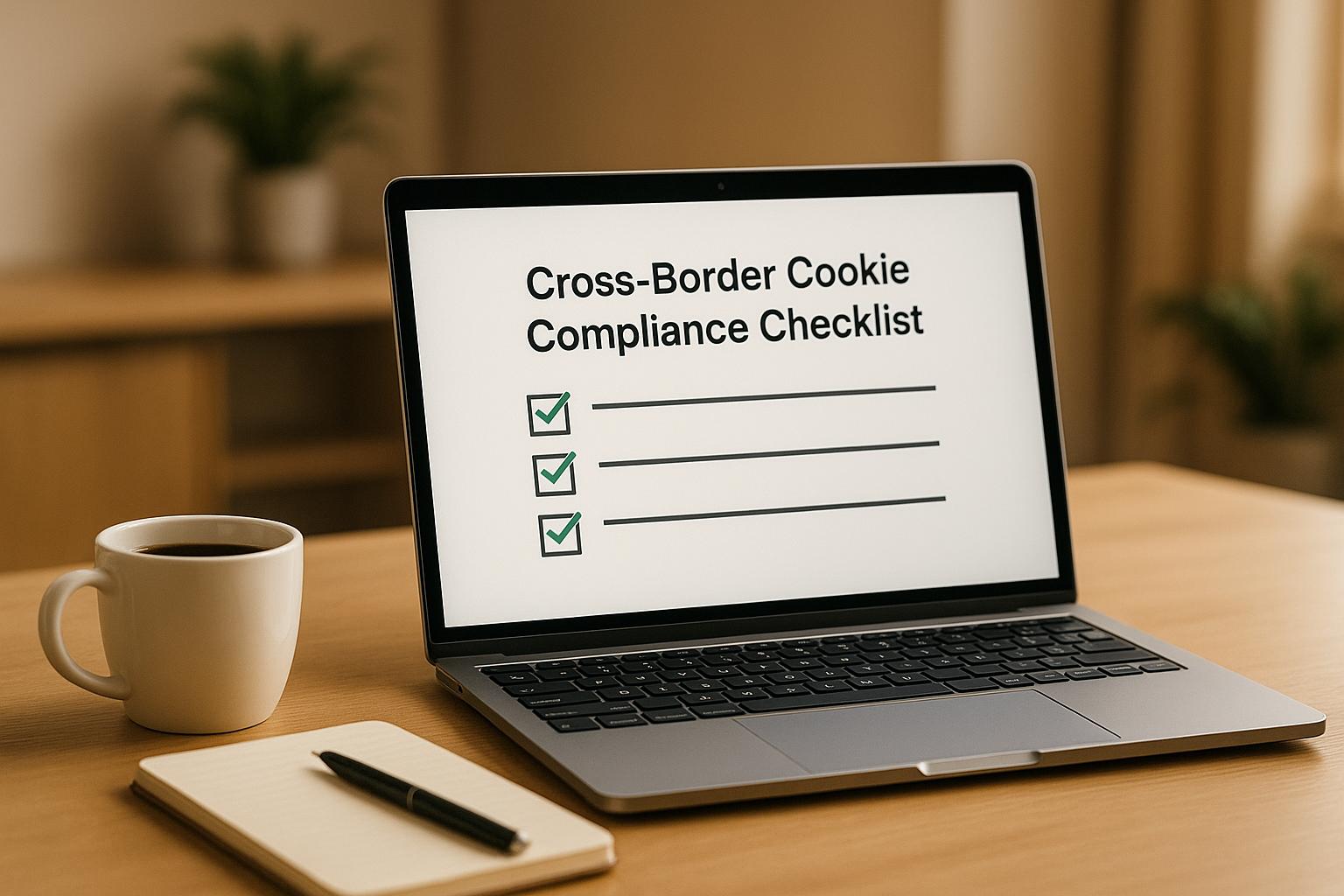Cross-Border Cookie Compliance Checklist

Cookie compliance is a global challenge, with different regions enforcing distinct rules. Missteps can lead to fines, legal issues, and loss of user trust. Here’s what you need to know:
- Why it matters: Non-compliance risks hefty fines - up to €20M under GDPR. User privacy is a growing concern, with only 25% of users in Germany and France accepting cookies, compared to 80% in the U.S.
- Key regulations:
- EU/EEA: Requires explicit opt-in consent for non-essential cookies (GDPR).
- USA: Opt-out model (CPRA, CCPA).
- Brazil: Explicit opt-in (LGPD).
- South Africa: Informed opt-in (POPIA).
- Steps to compliance:
- Audit all cookies and data flows.
- Use consent banners tailored to local laws.
- Block non-essential cookies until consent is given.
- Maintain detailed consent records for audits.
- Regularly review and update your practices.
Enforcement trends: Regulators are cracking down harder, with fines increasing and a focus on technical compliance. Misleading banners, pre-checked boxes, or setting cookies before consent are common violations.
Future-proofing: As third-party cookies phase out, focus on first-party data, server-side tracking, and transparent consent mechanisms to build trust and meet regulations.
Conclusion: Staying compliant is an ongoing process that protects your business and builds user trust. Regular reviews, clear consent mechanisms, and proper documentation are key to avoiding penalties.
Cookie consent: mechanisms and practices for GDPR and ePrivacy compliance
Step-by-Step Cross-Border Cookie Compliance Checklist
Navigating cookie compliance across different countries can be tricky, but a structured approach makes it manageable. Here's a step-by-step guide to help you build a system that meets the requirements wherever you operate.
Audit Your Cookies and Data Flows
The first step is to identify every cookie on your website. This includes cookies from third-party scripts, analytics tools, and marketing platforms.
Use automated scanning tools to uncover all cookies on your site. Manual checks often miss hidden cookies that only activate under certain conditions, like specific user actions or page visits. Once identified, categorize the cookies into four main types: strictly necessary (e.g., shopping cart functionality), preferences (user settings), statistics (analytics), and marketing (advertising and tracking).
Map out how user data flows through your systems, especially for cross-border transfers. Highlight where data is stored, how long it's retained, and who has access to it. This step is critical for cross-border operations. For example, if your site uses Google Analytics and serves EU users, the data may be sent to U.S. servers, triggering additional GDPR requirements.
Document the legal basis and data transfer safeguards for each third-party service you use. Tools like chatbots or email marketing platforms often set their own cookies and may transfer data internationally. With a clear map of cookies and data flows, you’ll be ready to configure consent mechanisms.
Set Up Consent Mechanisms
Implement consent banners tailored to regional requirements. These banners should offer clear options, such as "accept all", "reject all", or "customize by category", depending on the user's location. Avoid using pre-checked boxes or designs that nudge users into accepting cookies.
Ensure non-essential cookies are blocked until users give consent. This is especially important in regions like the EU, where opt-in rules apply. Use consent management platforms to prevent analytics, marketing, or tracking cookies from loading before users explicitly agree. Test your setup thoroughly - cookies firing before consent can result in hefty fines.
Design consent interfaces that are easy to understand and free of legal jargon. Users should clearly see what they're agreeing to, including details about data transfers to other countries. Make it simple for them to revisit and change their preferences later.
For businesses collecting lead information through forms, tools like Reform can help you design branded, customizable consent forms that integrate smoothly with your compliance efforts. Once your consent process is in place, document and secure user choices in your audit trails.
Keep Consent Records and Audit Trails
Maintaining detailed consent logs is crucial for demonstrating compliance. These logs should include information like the user's consent status, timestamp, specific preferences (e.g., which cookie categories they accepted or rejected), the version of the consent banner displayed, and the user's location at the time of consent.
Secure these records and ensure they’re easily accessible. If regulators investigate, they’ll expect you to quickly show how you comply with cookie laws. Your audit trail should demonstrate not only what users consented to but also how your systems respected those choices.
Regularly review your consent logs to ensure they’re accurate and complete. Missing or inconsistent data could signal technical issues that need immediate attention. Set up automated alerts to catch unusual patterns, such as sudden drops in consent rates, which might indicate a problem with your system.
Document your compliance measures thoroughly. This includes showing how you prevent cookies from being set prematurely, handle consent withdrawals, and maintain data accuracy across regions.
Update Regularly to Stay Compliant
Review your compliance practices every quarter or whenever significant changes occur in your business or the regulatory environment.
Be prepared to update your processes when necessary. New privacy laws, changes in third-party providers, browser updates, or modifications to your website’s functionality all require a reassessment of compliance measures. For instance, when California’s CPRA came into effect, many businesses had to adjust their consent mechanisms to align with its opt-out requirements.
Keep an eye on enforcement trends and adapt quickly to new regulations. Authorities are increasingly scrutinizing technical implementations, not just visible consent banners, and penalties are becoming harsher.
Monitor changes in browser privacy settings, as these can impact cookie behavior. With browsers phasing out third-party cookies and introducing stricter privacy controls, your compliance strategy may need adjustments. After every update, test your cookie systems to ensure everything functions correctly. Even a small change can disrupt your consent mechanisms.
Common Cookie Compliance Challenges
Once you've set up your compliance processes, it's equally important to identify common pitfalls and stay aware of enforcement trends. Overlooking these challenges can lead to costly mistakes and regulatory issues.
Common Compliance Mistakes to Avoid
One frequent error is setting cookies before obtaining valid user consent. Analytics scripts, marketing pixels, and third-party tools often activate as soon as a webpage loads, regardless of user preferences. Regulators increasingly scrutinize the technical behavior of cookies, not just what users see on consent banners.
Another major violation is using pre-checked boxes on consent forms. Some businesses still have marketing or analytics cookies selected by default, forcing users to actively uncheck them to opt out. This practice is explicitly prohibited under GDPR and similar regulations.
Misleading consent banners pose significant risks as well. Common design issues include making the "accept all" button more prominent than "reject all", using vague or confusing language, or hiding granular cookie controls behind multiple clicks. While these tactics might boost acceptance rates temporarily, they fail to meet user-centric consent standards.
Incorrectly labeling non-essential cookies as "necessary" is another widespread problem. For example, analytics cookies are often misclassified as essential when they're actually optional. Users must be given a real choice, with clear explanations of what each cookie category does.
Failing to adapt consent mechanisms for different regions can also lead to compliance gaps. For instance, a system that aligns with California's opt-out model may violate Germany's stricter opt-in requirements for non-essential cookies .
Understanding these missteps is critical, especially as regulators now focus on both the design and technical implementation of consent systems.
Current Enforcement Trends
Regulatory enforcement has shifted gears, moving from warnings to imposing serious fines. In 2025, Sweden's Data Protection Authority penalized ATG and Warner Music Sweden for using manipulative cookie banners. These actions targeted designs that confused or misled users, emphasizing real-world user experiences.
Under GDPR, fines can reach up to €20 million or 4% of a company's global turnover. Importantly, enforcement isn't limited to tech giants anymore - smaller businesses are also being held accountable, demonstrating that compliance applies to everyone.
In February 2025, the European Commission withdrew the proposed ePrivacy Regulation, leaving the ePrivacy Directive as the primary legal framework. This has empowered regulators to apply cookie compliance rules uniformly across EU member states.
In the U.S., enforcement is also ramping up. Under Executive Order 14117, the Department of Justice introduced new rules that took effect on April 8, 2025, with a grace period ending July 8, 2025. By October 6, 2025, companies must complete formal risk assessments for data transfers to certain countries, including China, Russia, and North Korea.
Regulators now prioritize practical compliance over theoretical interpretations, focusing on how systems work in practice, both technically and from the user's perspective.
Document Your Compliance Efforts
Thorough documentation is your best defense during audits or investigations. Keep detailed consent records and maintain an up-to-date cookie inventory that clearly outlines data flows and their legal bases .
Demonstrate how your systems prevent cookies from being set prematurely, handle consent withdrawals, and ensure data accuracy across regions. Supporting evidence like screenshots of consent banners, technical configurations, and audit results can strengthen your case.
Maintain an audit trail to track changes to your compliance systems over time. For example, when updating consent mechanisms, adding new tools, or modifying cookie categories, document the changes along with dates and reasons. This historical record shows your commitment to ongoing compliance.
If your business uses lead generation forms, platforms like Reform can simplify documentation by automatically logging consent interactions and providing exportable audit trails. These records can be invaluable if regulators question your practices.
Regular compliance reviews should produce formal reports summarizing your current status, highlighting risks, and outlining steps to address them. Store these reports securely, making them accessible to legal teams, compliance officers, and auditors when needed.
sbb-itb-5f36581
Alternatives to Third-Party Cookies and Future-Proofing Compliance
As third-party cookies phase out, it's time to shift toward privacy-focused strategies. These changes aren't just about meeting new regulations - they also set businesses up for long-term success in a more privacy-conscious world.
Shift to First-Party Data
First-party data is information you gather directly from your users through your own platforms. Unlike third-party cookies, this approach involves creating a direct relationship with your audience. Instead of relying on passive tracking, businesses can encourage users to willingly share their data by offering clear value, like personalized offers or exclusive content.
Another privacy-friendly tactic is contextual advertising. Here, ads are displayed based on the content of a webpage rather than tracking individual users. For instance, showing an ad for running shoes on a sports news article connects with the audience's intent while respecting their privacy.
Additionally, server-side tracking offers a more secure alternative. By storing data on your own servers instead of using external scripts, you gain better control over your data and reduce reliance on third-party tools. Combine this with consent-driven tools to create a seamless and privacy-compliant data strategy.
Leverage Consent-Driven Tools
Consent-driven tools are essential for modern compliance. They integrate user consent directly into your data collection process, ensuring transparency and trust. Tools like Reform, a no-code form builder, make this process easier. With features such as multi-step forms, conditional routing, email validation, and spam prevention, businesses can gather high-quality data while respecting user preferences. Real-time analytics and seamless integration with marketing and CRM tools ensure that consent records are accurate and actionable.
Get Ready for the Changing Cookie Landscape
To navigate the evolving cookie landscape, businesses must stay ahead of browser policy updates and regulatory changes. Adopting flexible consent solutions is key - these modular tools allow companies to adapt quickly as new laws emerge. Regular training for staff and routine compliance reviews can help identify and address risks before they become issues.
Building transparent data practices and fostering direct customer relationships will not only replace third-party cookies but also strengthen compliance across borders. Companies that embrace these strategies early will gain a solid edge in the post-cookie era. By prioritizing privacy and trust, businesses can turn this challenge into an opportunity for growth.
Conclusion and Key Takeaways
Cross-border cookie compliance is not a "set it and forget it" task. It requires constant attention, especially as regulations evolve and enforcement becomes more stringent worldwide. Businesses that stay ahead of these changes can not only avoid hefty penalties but also build stronger, trust-based relationships with their users. The practices outlined earlier provide a solid foundation for navigating this complex landscape.
Key Points to Remember
At the heart of cross-border cookie compliance are four critical actions: auditing cookies, implementing granular consent, maintaining audit trails, and regularly updating practices. These steps ensure that your business complies with both local and international regulations, reducing the risk of penalties.
The financial risks are high - violations under GDPR and LGPD can lead to severe fines. Beyond avoiding these penalties, though, a strong compliance strategy builds user trust, promotes transparency, and ensures smoother global operations.
Regional differences in user acceptance rates highlight the need for customized approaches to consent.
Detailed documentation is key. Keeping thorough records of user consents, policy updates, and technical measures like cookie-blocking tools demonstrates your commitment to privacy. Regularly reviewing consent logs and using automated tools to track compliance can help you stay audit-ready.
Future Trends in Cookie Compliance
As the regulatory landscape continues to evolve, businesses must prepare for several emerging trends. Enforcement is becoming stricter, with regulators shifting from warnings to imposing significant fines on businesses of all sizes. The European Commission's decision to withdraw the ePrivacy Regulation in February 2025 leaves the ePrivacy Directive as the primary legal framework, signaling more aggressive and uniform enforcement efforts ahead.
The phase-out of third-party cookies is pushing companies to adopt first-party data strategies. Businesses that invest in consent-driven tools and build direct relationships with customers will be better positioned to thrive in a privacy-conscious world. For advertisers, tools like Google Consent Mode v2 are becoming increasingly important, especially in regions like the UK and the European Economic Area, where balancing analytics with compliance is critical.
Consent design is also undergoing a transformation. Modern consent banners are prioritizing clarity, simplicity, and accessibility, enhancing the user experience while meeting compliance standards. Transparent, user-friendly consent processes can lead to greater trust and engagement.
Finally, the regulatory environment is becoming more fragmented, with regional variations in enforcement and data localization requirements. To stay ahead, businesses must monitor these changes closely and implement systems that can quickly adapt to new demands. By embracing these shifts proactively, compliance can become a competitive edge rather than a burden.
FAQs
What are the main differences in cookie compliance rules between regions like the EU, the US, and Brazil?
Cookie rules differ widely depending on where you are, thanks to variations in privacy laws and regulations.
In the EU, the General Data Protection Regulation (GDPR) and the ePrivacy Directive require businesses to get explicit consent from users before placing or accessing cookies on their devices. This means companies must clearly explain what types of cookies are being used and why.
In the US, cookie regulations are more fragmented. There’s no federal law specifically addressing cookies, but state laws like the California Consumer Privacy Act (CCPA) require businesses to disclose their cookie usage and give users the option to opt out of certain data collection practices.
In Brazil, the General Data Protection Law (LGPD) takes a similar approach to the GDPR. It requires businesses to secure user consent for cookies and emphasizes transparency about how the collected data will be used.
For businesses, staying compliant means adapting their cookie consent processes to align with the rules in each region where they operate.
What steps can businesses take to manage and document user consent for compliance with international cookie laws?
To meet the requirements of international cookie laws, businesses must manage and document user consent properly. This means using tools that can create clear and customizable consent forms to capture user preferences effectively. One such tool is Reform, a no-code form builder that helps businesses design user-friendly forms tailored to include consent options, making compliance easier.
Reform offers features like multi-step forms and conditional routing, which guide users through the consent process smoothly. On top of that, its real-time analytics provide insights into user interactions, helping businesses improve consent rates and maintain accurate records of user decisions.
How can businesses move away from third-party cookies while staying compliant and maintaining user trust?
To transition away from third-party cookies while keeping user trust intact and staying compliant, businesses can adopt several practical strategies. One of the most effective steps is to rely on first-party data - information gathered directly from users through their interactions on your website or app. This method not only respects user privacy but also strengthens the connection between your brand and your audience.
Another important approach is to use privacy-first analytics tools. These tools emphasize transparency and ensure user consent is front and center. Be upfront about how you collect and use data, and always get clear, explicit permission. This kind of openness helps build trust and keeps you aligned with privacy regulations.
You can also explore tools like Reform to design simple, user-friendly forms that collect the information you need without compromising privacy. By focusing on compliance and creating a positive user experience, businesses can smoothly adapt to a world without third-party cookies.
Related Blog Posts
Get new content delivered straight to your inbox

The Response
Updates on the Reform platform, insights on optimizing conversion rates, and tips to craft forms that convert.
Drive real results with form optimizations
Tested across hundreds of experiments, our strategies deliver a 215% lift in qualified leads for B2B and SaaS companies.





